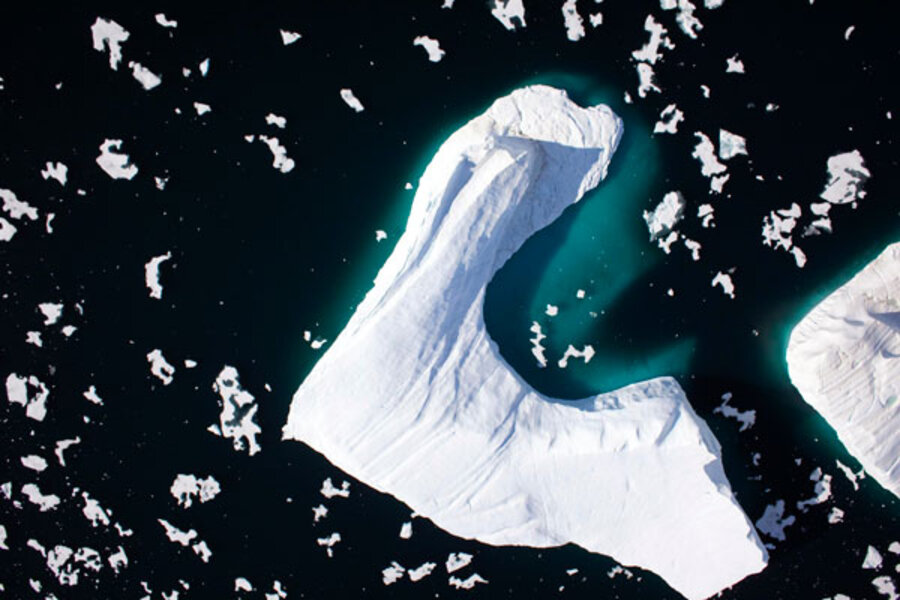Greenland has its own Grand Canyon deep under ice, study says
Loading...
A canyon similar in scale, if not in grandeur, to Arizona's Grand Canyon lies beneath Greenland's ice sheet, according to a new study.
Running from deep within the island's interior north to Greenland's northwest coast, the canyon measures at least 470 miles long, six miles across at its widest, and as many as 2,600 feet deep – reaching its widest and deepest points near the coast. The Grand Canyon, by comparison, is 277 miles long, 18 miles wide, and 6,000 feet deep.
The portrait points to how little scientists know about what lies beneath the world's great ice sheets. It also could help researchers understand how the ice sheet and melt water are working together to feed outlet glaciers along a coast where glaciers have been thinning at an increasing pace within the past decade.
Mapping Greenland's hidden landscape is important "so we can understand how the ice sheet is presently routing mass out toward its edges and how the ice sheet and water underneath the ice will interact," says Mark Fahnsetock, a geophysicist at the University of Alaska at Fairbanks.
In addition, the discovery could help solve a longstanding riddle: Why does Antarctica's ice sheet have lakes underneath it, but Greenland's ice sheet apparently does not? For the region the canyon traverses, the answer may be that the island has more efficient plumbing, says Dr. Fahnsetock, who was not involved in the study.
The first hints that the island's ice sheet, nearly two miles thick, was hiding such a feature emerged in the later 1990s. But the evidence was limited. No one anticipated a canyon of such magnitude.
The canyon lacks features that would signal it was formed by glaciers, suggesting that its predates the initial appearance of glaciers there about 38 million years ago, according to the team led by Jonathan Bamber, a glaciologist at the University of Bristol in Britain. His team built a profile of the canyon using 40 years of ice-penetrating radar data, which show the canyon meandering in ways that suggest it was carved by a large river system.
The team concludes that water would have flowed through the canyon constantly until Greenland's island-wide ice sheet formed 3.5 million years ago. Once the ice sheet formed, its pressure would have pushed water at the base out of the canyon in some locations. But the canyon would have remained a major route for under-ice water as it flowed toward the coast and under what today is known as the Petermann Glacier.
That could help explain why the ice shelf at the end of the Petermann Glacier has been prone to high rates of melting. The ice shelf is grounded in a fjord, and scientists have thought that warm sea water was entering the fjord and melting the shelf from underneath.
Now, it turns out that the shelf also could be under assault form melt water moving north through the canyon in what the research team calls "well-organized" flows. Indeed, scientists have uncovered deep, wide channels carved upward into the underside of the shelf, suggesting that the underside is exposed to relatively focused, rapidly flowing melt water. Researchers also have discovered a hydrothermal heat source near the northern end of the canyon, which would increase the amount of melt water at the base of the ice as it moves over the hot spot.
A formal presentation of the results is set to appear in Friday's issue of the journal Science.
For Eric Rignot, who has mapped Greenland's coastal areas, including the northern end of the canyon, the extent of the canyon is an eye-opener.
"It didn't occur to me that the canyon could go that far inland," says Dr. Rignot, a glaciologist at the University of California, Irvine and a senior scientist at NASA's Jet Propulsion Laboratory in Pasadena, Calif. "We did not even bother looking at that."
Researchers are keeping a keen eye on the region.
The northern end of the canyon represents a conduit for ice moving down from the ice sheet, but it also represents a pathway for ocean water to migrate inland to continue melting the glacier from underneath if the Petermann ice shelf breaks up and the glacier retreats.
"The ocean water will basically follow the ice along that canyon," he says.
If nothing else, the study "shows how little we still know about the bedrock below large continental ice sheets," said Michael Studinger, project scientist for a NASA ice-monitoring program whose data played a significant role in uncovering the canyon, in a prepared statement.





